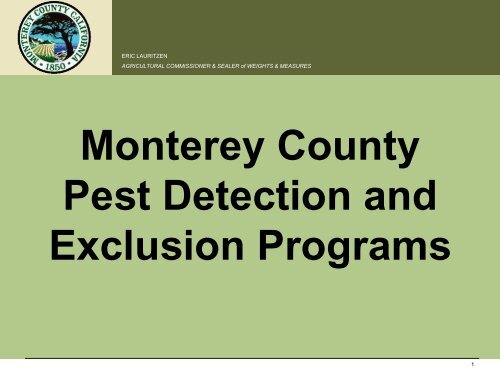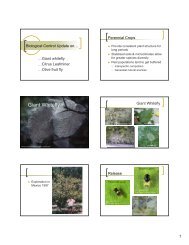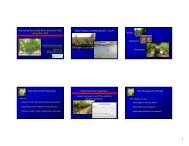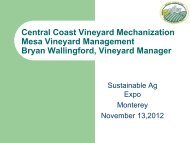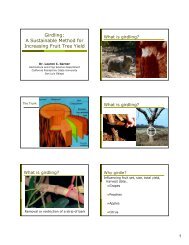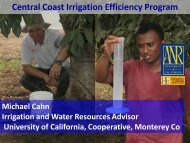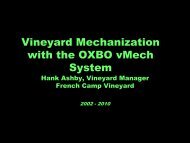Monterey County Pest Detection and Exclusion Programs
Monterey County Pest Detection and Exclusion Programs
Monterey County Pest Detection and Exclusion Programs
Create successful ePaper yourself
Turn your PDF publications into a flip-book with our unique Google optimized e-Paper software.
ERIC LAURITZEN<br />
AGRICULTURAL COMMISSIONER & SEALER of WEIGHTS & MEASURES<br />
<strong>Monterey</strong> <strong>County</strong><br />
<strong>Pest</strong> <strong>Detection</strong> <strong>and</strong><br />
<strong>Exclusion</strong> <strong>Programs</strong><br />
1
<strong>Pest</strong> <strong>Detection</strong> Program<br />
ERIC LAURITZEN<br />
AGRICULTURAL COMMISSIONER & SEALER of WEIGHTS & MEASURES<br />
A. The primary responsibilities:<br />
A. Early <strong>Detection</strong> <strong>and</strong> Eradication<br />
B. Statewide Trapping Program<br />
B. The primary objectives<br />
A. To find insect pests before they infest an area<br />
B. Insects targeted for detection:<br />
a) Fruit flies (Oriental, Medfly, etc.)<br />
b) Japanese beetle,<br />
c) Gypsy moth<br />
d) Asian Citrus Psyllid.<br />
2
<strong>Exclusion</strong> Program<br />
ERIC LAURITZEN<br />
AGRICULTURAL COMMISSIONER & SEALER of WEIGHTS & MEASURES<br />
A. The Agricultural Commissioner, in cooperation with<br />
CDFA <strong>and</strong> USDA work to enforce:<br />
A. Federal, Foreign <strong>and</strong> Domestic Quarantines<br />
B. California <strong>and</strong> <strong>County</strong> Quarantines<br />
<strong>Pest</strong> exclusion is the cornerstone of keeping exotic<br />
pests from invading<br />
3
<strong>Exclusion</strong> Inspections<br />
ERIC LAURITZEN<br />
AGRICULTURAL COMMISSIONER & SEALER of WEIGHTS & MEASURES<br />
A. Exterior <strong>Pest</strong> <strong>Exclusion</strong><br />
A. border station inspections of vehicles<br />
B. Interior <strong>Pest</strong> <strong>Exclusion</strong><br />
A. Enforcement of quarantines<br />
B. Inspection of packages<br />
C. Phytosanitary certification<br />
C. Nursery <strong>and</strong> Seed<br />
A. Licensing<br />
B. Plant cleanliness<br />
C. Registration <strong>and</strong> certification<br />
D. Truth in labeling<br />
4
Export Requirements<br />
ERIC LAURITZEN<br />
AGRICULTURAL COMMISSIONER & SEALER of WEIGHTS & MEASURES<br />
A. Phytosanitary Certification<br />
A. Shipments for export must be certified<br />
B. Certify the commodity is free of pests of concern<br />
B. Agricultural Commissioner staff<br />
A. Provide inspection <strong>and</strong> certification<br />
B. Issue federal <strong>and</strong> state certificates<br />
5
Nursery Program<br />
ERIC LAURITZEN<br />
AGRICULTURAL COMMISSIONER & SEALER of WEIGHTS & MEASURES<br />
The mission of the Nursery Program<br />
A. Prevent the introduction <strong>and</strong> spread of pests<br />
B. Protect against economic losses<br />
The Nursery Program fulfills two roles:<br />
A. Coordinate inspection <strong>and</strong> regulatory activities<br />
B. Provide registration <strong>and</strong> certification<br />
6
Seed Law Enforcement<br />
ERIC LAURITZEN<br />
AGRICULTURAL COMMISSIONER & SEALER of WEIGHTS & MEASURES<br />
Seed Program<br />
A. Regulates the marketing of seeds<br />
B. Tests for seed purity <strong>and</strong> germination<br />
C. Investigates seed complaints<br />
D. Works to prevent the transmission of weed seeds<br />
The goal of seed law enforcement is to protect<br />
consumers<br />
7
Field Communications<br />
<strong>Monterey</strong> <strong>County</strong><br />
Agricultural Commissioner’s Office
Grower/Packer communication<br />
Communication with irrigators<br />
Communication with nearby residents<br />
Different types of posting signs<br />
Neighbor responsibilities with fumigants<br />
Phase II fumigant update
Grower/Packer Communication
Purpose of Regulations<br />
• Worker right-to-know<br />
• Potential work site<br />
pesticide hazards<br />
• Unimpeded to their<br />
pesticide use records<br />
• Prevent employees<br />
from entering fields<br />
before it is safe
Field Worker <strong>Pest</strong>icide Safety Training<br />
Training is required:<br />
• Before working in a<br />
treated field<br />
• At least once every 5<br />
years<br />
• Conducted by a<br />
Qualified trainer<br />
• In a language<br />
employee<br />
underst<strong>and</strong>s
Application-Specific Information:<br />
• Must be at a central<br />
location<br />
• Within 24 hours of<br />
completed application<br />
• Prior to fieldworkers<br />
entering a field<br />
• Displayed for 30 days<br />
plus REI<br />
Fieldworkers
Notice of Application<br />
Employer’s Responsibility<br />
Employers must tell<br />
employees <strong>and</strong><br />
contractors working<br />
within ¼ mile:<br />
• REI<br />
• Date of application<br />
• Location<br />
• Not to enter the field
Emergency Medical Care Knowledge<br />
• Planned in advance<br />
• Employees or<br />
supervisor informed<br />
• Employees must be<br />
taken to a physician<br />
immediately when you<br />
suspect an illness
Communication with Irrigators
Basic Requirements of an<br />
Restricted Entry Interval (REI)<br />
• Employees must not go<br />
into a field for any reason<br />
for at least four (4) hours<br />
following any pesticide<br />
application<br />
• Unless they will not touch<br />
surfaces with pesticide<br />
residue<br />
• No h<strong>and</strong> labor tasks are<br />
allowed during the REI
Accepted Irrigation Activities<br />
During an REI
Workers With No Contact<br />
• Greenhouses - After any<br />
inhalation exposure<br />
level, or ventilation<br />
criteria has been met<br />
• WPS provides for entry<br />
without PPE only when<br />
there will be no contact<br />
with the pesticides or<br />
pesticide residues
Accepted Irrigation Activities<br />
During an REI (No Contact continued)<br />
• Workers may walk, or<br />
perform other tasks<br />
• In furrows after the<br />
pesticides have been<br />
applied to the soil<br />
surface<br />
• Provided there is no<br />
contact with treated<br />
surfaces
Communication with<br />
Nearby Residents
Label Buffer Requirements<br />
• Certain pesticides have<br />
label specific air or ground<br />
application buffer<br />
distances<br />
• Read <strong>and</strong> follow the label<br />
• Check your permit for<br />
additional conditions
Posting Requirements<br />
• Federal Requirements<br />
• State Requirements<br />
• <strong>Monterey</strong> <strong>County</strong> Posting Regulation
State Posting<br />
Regulations<br />
Field Posting Required if:<br />
• Label requires double<br />
notification<br />
• REI > 7 days<br />
• Field Fumigations<br />
Mty <strong>County</strong> Posting<br />
Regulation<br />
Field Posting Required if:<br />
• REI 24 hours, or more
State Posting<br />
Regulations<br />
• Dormant, pre-plant<br />
<strong>and</strong> pre-emergent<br />
applications<br />
• Post every 600 feet<br />
along public, unfenced<br />
right-of-way<br />
Mty <strong>County</strong> Posting<br />
Regulation<br />
• No posting for<br />
dormant, pre-plant, or<br />
pre-emergent or<br />
applications not made<br />
directly onto plant<br />
foliage<br />
• Additional language<br />
when REI > 7 days or<br />
when a fumigant is<br />
applied
Posting at Greenhouses
California Code of Regulations Requires:<br />
• Posting for all<br />
greenhouse<br />
pesticide<br />
applications<br />
• Regardless of<br />
restricted entry<br />
interval (REI)
Label Required Field Postings
Fumigation Posting
Neighbor Responsibilities &<br />
Fumigants
What are my<br />
responsibilities after<br />
signing a Buffer Zone<br />
encroachment agreement?<br />
• Allow Inner Buffer Zone<br />
(IBZ) signs to be on your<br />
property<br />
• Assure no one enters the<br />
IBZ for the duration of the<br />
Restricted Entry Interval<br />
(except to transit)<br />
• Notify employees, Farm<br />
Labor Contractors, <strong>and</strong><br />
<strong>Pest</strong> Control Businesses of<br />
the IBZ
What are my<br />
responsibilities<br />
after signing an<br />
Outer Buffer Zone<br />
(OBZ) agreement?<br />
• Assure that one enters the<br />
OBZ except to transit, or to<br />
perform farm labor<br />
activities<br />
• Provide notice to employees
Phase II Fumigant Updates
Difficult to Evacuate Sites<br />
Labels now specifically identify<br />
“Difficult to Evacuate Sites”<br />
• State licensed daycare<br />
centers<br />
• Assisted living facilities<br />
• Schools (K-12)<br />
• Nursing homes<br />
• Hospitals<br />
• In-patient clinics<br />
• Prisons
Emergency Preparedness <strong>and</strong><br />
Response Measures<br />
Intended to:<br />
• Prevent risks from<br />
the use of fumigants<br />
• Prepare in case of an<br />
emergency<br />
• Requirement based<br />
on size of buffer<br />
zone <strong>and</strong> distance to<br />
people
Summary<br />
Grower/Packer communication<br />
Communication with irrigators<br />
Communication with nearby residents<br />
Different types of posting signs<br />
Neighbor responsibilities with fumigants<br />
Phase II fumigants update
Questions ?


